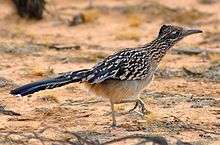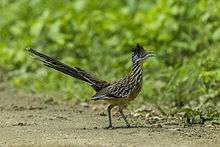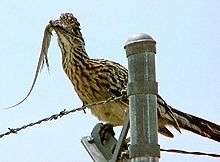Roadrunner
The roadrunners (genus Geococcyx), also known as chaparral birds or chaparral cocks, are two species of fast-running ground cuckoos with long tails and crests. They are found in the southwestern and south-central United States and Mexico,[1][2] usually in the desert. Some have been clocked at 32 km/h (20 mph) while a few have also been clocked up to 43 km/h (27 mph).
| Roadrunner | |
|---|---|
 | |
| Greater roadrunner (Geococcyx californianus) | |
| Scientific classification | |
| Kingdom: | Animalia |
| Phylum: | Chordata |
| Class: | Aves |
| Order: | Cuculiformes |
| Family: | Cuculidae |
| Subfamily: | Neomorphinae |
| Genus: | Geococcyx Wagler, 1831 |
| Species | |
Species
The subfamily Neomorphinae, the New World ground cuckoos, includes 11 species of birds,[3] while the genus Geococcyx has just two:[4]
| Image | Scientific name | Common Name | Distribution |
|---|---|---|---|
 | G. californianus | greater roadrunner | Mexico and the southwestern and south-central United States[5] |
 | G. velox | lesser roadrunner | Mexico and Central America [6] |
Morphology
The roadrunner generally ranges in size from 56 to 61 cm (22 to 24 in) from tail to beak. The average weight is about 230–430 g (8–15 oz)}.[7] The roadrunner is a large, slender, black-brown and white-streaked ground bird with a distinctive head crest. It has long legs, strong feet, and an oversized dark bill. The tail is broad with white tips on the three outer tail feathers. The bird has a bare patch of skin behind each eye; this patch is shaded blue anterior to red posterior. The lesser roadrunner is slightly smaller, not as streaky, and has a smaller bill. Both the lesser roadrunner and the greater roadrunner leave behind very distinct "X" track marks appearing as if they are travelling in both directions.[8]
Roadrunners and other members of the cuckoo family have zygodactyl feet. The roadrunner can run at speeds of up to 32 km/h (20 mph)[9] and generally prefer sprinting to flying, though it will fly to escape predators.[10] During flight, the short, rounded wings reveal a white crescent in the primary feathers.
Vocalization
The roadrunner has a slow and descending dove-like "coo". It also makes a rapid, vocalized clattering sound with its beak.[11]
Geographic range

Roadrunners inhabit the southwestern United States, eastward to parts of Missouri, Arkansas, and Louisiana, as well as Mexico and Central America. They live in arid lowland or mountainous shrubland or woodland. They are non-migratory, staying in their breeding area year-round.[12] The greater roadrunner is not currently considered threatened in the US, but is habitat-limited.[13]
Food and foraging habits
The roadrunner is an opportunistic omnivore. Its diet normally consists of insects (such as grasshoppers, crickets, caterpillars, and beetles), small reptiles (such as lizards, collared lizards, and snakes, including rattlesnakes),[14] rodents and other small mammals, spiders (including tarantulas), scorpions, centipedes, snails, small birds (and nestlings), eggs, and fruits and seeds like those from prickly pear cactuses and sumacs. The lesser roadrunner eats mainly insects. The roadrunner forages on the ground and, when hunting, usually runs after prey from under cover. It may leap to catch insects, and commonly batters certain prey against the ground. Because of its quickness, the roadrunner is one of the few animals that preys upon rattlesnakes;[15] it is also the only real predator of tarantula hawk wasps.[12]
Behavior and breeding
The roadrunner usually lives alone or in pairs. Breeding pairs are monogamous and mate for life,[16] and pairs may hold a territory all year. During the courtship display, the male bows, alternately lifting and dropping his wings and spreading his tail. He parades in front of the female with his head high and his tail and wings drooped, and may bring an offering of food. The reproductive season is spring to mid-summer (depending on geographic location and species).[12]
The roadrunner's nest is often composed of sticks, and may sometimes contain leaves, feathers, snakeskins, or dung.[17] It is commonly placed 1 to 3 meters (3 to 10 feet) above ground level[18] in a low tree, bush, or cactus. Roadrunner eggs are generally white. The greater roadrunner generally lays 2–6 eggs per clutch, but the lesser roadrunner's clutches are typically smaller. Hatching is asynchronous. Both sexes incubate the nest (with males incubating the nest at night) and feed the hatchlings. For the first one to two weeks after the young hatch, one parent remains at the nest. The young leave the nest at two to three weeks old, foraging with parents for a few days after.[12]
_2.jpg)
Thermoregulation
During the cold desert night, the roadrunner lowers its body temperature slightly, going into a slight torpor to conserve energy. To warm itself during the day, the roadrunner exposes dark patches of skin on its back to the sun.[12]
Indigenous lore
The Hopi and other Pueblo tribes believed that roadrunners were medicine birds and could protect against evil spirits. Their unusual X-shaped footprints are used as sacred symbols to ward off evil in many Pueblo tribes—partially because they invoke the protective power of the roadrunners themselves, and partially because the X shape of the tracks conceals which direction the bird is headed (thus throwing malignant spirits off track.) Stylized roadrunner tracks have been found in the rock art of ancestral Southwestern tribes like the Anasazi and Mogollon cultures, as well. Roadrunner feathers were traditionally used to decorate Pueblo cradleboards as spiritual protection for the baby. In Mexican Indian and American Indian tribes, such as the Pima, it is considered good luck to see a roadrunner. In some Mexican tribes, the bird was considered sacred and never killed, but most Mexican Indians used the meat of the roadrunner as a folk remedy to cure illness or to boost stamina and strength.[19]
Indigenous peoples of Central America have developed numerous beliefs about the roadrunner. The Ch’orti’, who call it t’unk’u’x or mu’, have taboos against harming the bird.[20] The Ch'ol Maya believe roadrunners to have special powers. It is known to them as ajkumtz’u’, derived from the bird's call that is said to make the listener feel tired.[21]
The word for roadrunner in the Oʼodham language is taḏai, which is the name of a transit center in Tucson, Arizona.[22][23]

Notes
- "roadrunner". The Free Dictionary. Farlex. Retrieved 3 May 2012.
- "roadrunner". Merriam Webster. Retrieved 3 May 2012.
- Myers, P. R.; Parr, C. S.; Jones, T.; Hammond, G. S.; Dewey, T. A. "Neomorphinae (New World ground cuckoos)". Animal Diversity Web. University of Michigan. Retrieved 2009-08-12.
- Avian Web. "Roadrunners". Retrieved 3 May 2012.
- "Greater Roadrunners". Avian Web. Retrieved 3 May 2012.
- "Lesser Roadrunners". Avian Web. Retrieved 3 May 2012.
- "Roadrunner". Desert Animals. The Animal Spot. Retrieved 3 May 2012.
- Elbroch, M.; Marks, E.; Boretos, D.C. (2001). Bird Tracks & Sign: A Guide to North American Species. Stackpole Books. p. 160. ISBN 978-0-8117-4253-5. Retrieved 2019-09-04.
- Lockwood, Mark (January 2010). Basic Texas birds: a field guide. Austin: University of Texas Press. pp. 168–169. ISBN 978-0-292-71349-9.
- "Greater Roadrunner Life History, All About Birds, Cornell Lab of Ornithology". Online bird guide, bird ID help, life history, bird sounds from Cornell. Retrieved 2019-09-02.
- "Bird Sounds".
- "Roadrunners". Avian Web. Retrieved 3 May 2012.
- Famolaro, Pete. "Greater Roadrunner (Geococcyx californianus)". California Partners in Flight Coastal Scrub and Chaparral Bird Conservation Plan. Point Blue. Archived from the original on 5 November 2004. Retrieved 21 Aug 2015.
No federal or state [management] status. No other special status. Unitt (1984) indicates that roadrunners are habitat limited and have experienced a reduction in numbers due to urbanization.
- "roadrunner vs rattlesnake".
- "The Roadrunner". Desert USA. Retrieved 3 May 2012.
- "With the exception of breeding pairs, roadrunners are solitary (Hughes 1996). Pairs mate for life (Terres 1980)."
- "Information on the Roadrunner | The Nature Conservancy". Nature.org. 2016-07-15. Retrieved 2016-09-14.
- "Usually 1-3 meters above ground; infrequently higher than 3 meters (Hughes 1996)."
- "Native American Indian Roadrunner Legends, Meaning and Symbolism from the Myths of Many Tribes". www.native-languages.org. Retrieved 2017-06-26.
- Hull, Kerry; Fergus, Rob (1 December 2017). "Birds as Seers: an Ethno-Ornithological Approach to Omens and Prognostication Among the Ch'Orti' Maya of Guatemala". Journal of Ethnobiology. 37 (4): 617. doi:10.2993/0278-0771-37.4.604.
- Hull, Kerry (2015-08-03). "Ethno-ornithological Perspectives on the Ch'ol Maya". Reitaku Review, Vol. 17, Pp. 42-92. Retrieved 2019-09-02.
- "TOHONO 'O'ODHAM-ENGLISH DICTIONARY" (PDF). University at Buffalo.
- "Tohono Tadai Transit Center - Transit.Wiki". www.transit.wiki. Retrieved 2017-06-26.
References
- Alsop III, Fred J. (2002). Birds of North America (1st American ed.). New York: DK. ISBN 0-7894-8001-8.
- del Hoyo, Josep; Baptista, Luis, eds. (1997). Sandgrouse to cuckoos. Barcelona: Lynx Ed. ISBN 84-87334-22-9.
- Harrison, George (2005). "Comical Cuckoo". Birder's World. 19: 56–58.
- Hutchins, Michael, ed. (2003). Grzimek's Animal Life Encyclopedia (2nd ed.). Detroit: Gale. ISBN 0-7876-5785-9.
- Meinzer, Wyman (1993). "Beep! Beep! Better pull over, folks – it's the roadrunner". Smithsonian. 23: 58.
- Perrins, Christopher M., ed. (1990). The Illustrated Encyclopedia of Birds: The Definitive Reference to Birds of The World (1st Prentice Hall Press ed.). New York: Prentice Hall Editions. ISBN 0-13-083635-4.
- National Geographic Society (2002). Field Guide to the Birds of North America (4th ed.). Washington D.C.: National Geographic. p. 244. ISBN 0792268776.
- Wetmore, Alexander; Kellog, Peter Paul (1965). Water, Prey, and Game Birds of Morth America. Washington D.C.: National Geographic Society.
Further reading
External links
| Wikimedia Commons has media related to Geococcyx. |